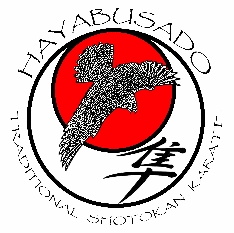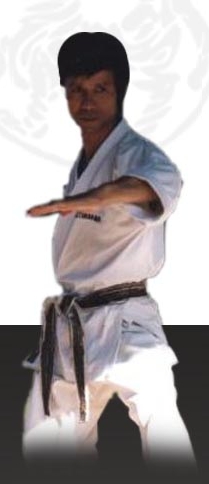There are three fundamental parts to Shotokan karate. Kihon, Kata and Kumite.
Kihon, meaning "basics" or "fundamentals", is by far the most
important part of the art of Karate.Without strong basic techniques we
cannot hope to perform effective karate. Kawasoe Sensei is regarded as
one of the greatest living karateka because his basic techniques are of a
standard many of us can only dream of attaining.
KATA
Kata is one of the training tools that the Karataka used to condition
there sub concise for instant response to attacks. Kata contains in
them stances, blocks, strikes and combinations of techniques that must
be used with out the slightest hesitation in order to insure your
survival.
In today's time kata serves all of these purpose and more. Kata helps
us to maintain a sense of origins of our art. Kata helps us to focus
our minds, and relieve stress. Kata strengthens our bodies and minds
into a single unit able to accomplish more together than apart. This
synergy is the secret that most non-karate practitioners can never hope
to understand or defeat.
The name Kata is a Japanese term translated as simply meaning form or
shape. Shotokan kata are sequences of basic, intermediate and advanced
techniques arranged into patterns of choreographed movements. Kata are
executed alone with the student encouraged to visualize the attacks of
an invisible enemy or multiple attackers whilst maintaining perfect
form.
Each kata has its own character. Some kata are strong and powerful
whereas others are far more graceful and flowing in their nature. Some
kata however, contain a mixture of both and each has its own unique
timing. The 26 officially recognised Shotokan kata are all individually
named and given their own personality. In some cases, the source of the
name is obvious. In others, the name of the kata can only be surmised
from the kanji that their identity was originally written in.
The Heian Kata
On the island of Okinawa, this group of kata were originally called
the 'Pinan' kata. The name Heian was given to them by Sensei Gichin
Funokoshi and is most commonly interpreted as meaning 'Peaceful Mind'.
The Heian kata are named in a fashion that indicates their level of
difficulty, i.e. one to five. With the exception of the Tekki kata, the
other Shotokan kata are not named with such a numerical identity.
The Tekki Kata
This group of three kata were originally called the Naihanchi kata.
Once again this name was replaced by Funokoshi Sensei to that of Tekki.
The name Tekki is taken from the character 'Tetsu' meaning iron or steel
and 'Ki' meaning to ride a horse or simply knight. One possible
translation of the name Tekki is 'Iron Knight'. The Tekki series are
easily identified as they are the only kata performed along a straight
line and exclusively in Kiba-Dachi.
The use of Dai and Sho in Kata
The Japanese kanji (characters) for Dai and Sho simply translate as
'Big/Greater' and 'Small/Lesser'. Despite a common misconception, Dai
kata are not anymore or any less advanced than their Sho versions.
Despite the translation, the Gojushiho kata are reversed. The 'Dai'
version of these two kata is actually shorter than that of 'Sho'.
Oyo Bunkai (Kata Application)
Oyo Bunkai is performed with training partners and allows a karate-ka
to breakdown and understand the application and interpretation for the
movements within each kata. Kata application can be obvious or elusive
depending on the technique or grouping of techniques in question and can
even contain more subtle, hidden variations. Without an understanding
of the Oyo Bunkai for each kata, they become nothing more than the
forming of shapes and an empty aerobic movement.
Basic Kata Terminology
Zanshin - A state of awareness. The literal translation is 'remaining mind'
Shizentai - Natural posture
Rei - Bow (performed silently)
Yoi - Ready position
Yame - Return to Yoi position
Naore - Return to 'shizentai' maintaining a state of 'zanshin'
Embusen - The invisible line on which kata is performed
Kiai - Meaning 'concentrated spirit'. A point in kata where the Karate-ka displays a vocal release of energy
Forms
 | Kihon Kata (First Cause)Also known as Taikyoku Shodan 20 movements, Kiai on movements 8 and 16.
Note:
Introduced for beginners as a somewhat simplified version of Heian
Shodan. It is used for 9th Kyu gradings as a "stepping-stone" to Heian
Shodan.
|
|
 | Heian Shodan (Peaceful Mind - Level 1)21 movements, Kiai on movements 9 and 17
|
|
 | Heian Nidan (Peaceful Mind - Level 2)26 movements, Kiai on movements 11 and 26
|
|
 | Heian Sandan (Peaceful Mind - Level 3)20 movements, Kiai on movements 10 and 20
|
|
 | Heian Yondan (Peaceful Mind - Level 4)27 movements, Kiai on movements 13 and 25
|
|
 | Heian Godan (Peaceful Mind - Level 5)23 movements, Kiai on movements 12 and 19
|
|
 | Tekki Shodan (Iron Knight - Level 1)29 movements, Kiai on movements 15 and 29
|
|
 | Tekki Nidan (Iron Knight - Level 2)24 movements, Kiai on movements 16 and 24
|
|
 | Tekki Sandan (Iron Knight - Level 3)36 movements, Kiai on movements 16 and 36
|
|
 | Bassai Dai (To penetrate a fortress)42 movements, Kiai on movements 19 and 42.
Note: On Okinawa, the "Bassai" kata were known as "Passai"
|
|
 | Kanku Dai (To view the sky)65 movements, Kiai on movements 15 and 65.
Note:
When an intermediate student of Shotokan Kata views Kanku-Dai for the
first time, there is always a sense of strong familiarity. This is
because the Kata is made up primarily of techniques and combinations
which appear in each of the 5 Heian Kata. It is widely believed that the
Heian Kata were in fact each a small excerpt of Kanku-Dai, broken up to
make learning this Kata easier for students. Whether this is true or
not is not important, however it is true to say that once a student has a
reasonable working knowledge of the 5 Heian Kata, Kanku-Dai is far
easier to learn.
|
|
 | Jion (Named after the temple Jion-Ji)47 movements, Kiai on movements 17 and 47.
Note:
This is the classic "mainstream" Shaolin Kata, complete with the "Ming"
salute at the beginning. Shaolin was also named Jion-Ji by the Japanese
but the literal translation of the Kanji is "to love the sound" (of
Shaolin).
|
|
 | Enpi (Flight of the swallow)37 movements, Kiai on movements 15 and 36.
Note:
A classic white crane style Kata brought to Okinawa in 1644 by Military
Attach� Master Wang-Shu. The Kata was named after him hence its
Okinawan name of "Wanshu". This translates to 'excellent or incredible
arms.
|
|
 | Jitte (Ten Hands)24 movements, Kiai on movements 13 and 24.
Note: Also known as "Jutte", If you master this Kata, your enemies will feel as though you have ten hands.
|
|
 | Hangetsu (Half Moon)41 movements, Kiai on movements 11 and 40.
Note:
This is a Wutang Kata that originated through Master Itosu's training
in Na-Ha-te from Master Higaonna. It is named after the third Chinese
Zen Patriarch but the name Hangetsu, given to it by Master Funakoshi,
means "half or crescent moon" - a description of the dominant stance
used in the Kata.
|
|
 | Gankaku (Crane standing upon a rock)42 movements, Kiai on movements 28 and 42.
Note:
A White Crane form, this time taught by Master Ching-To, attaché to
Okinawa from the Ming court in 1732, and so the Okinawans named it in
his honour "Chinto". Master Funakoshi later renamed it Gankaku.
|
|
 | Bassai Sho (To penetrate a fortress- small)27 movements, Kiai on movements 17 and 22
Note:
We are taught that Bassai-Dai symbolises the storming of a fortress and
that Bassai-Sho symbolises the fight to capture the enemy.
|
|
 | Kanku Sho (To view the sky - small)47 movements, Kiai on movements 6 and 47.
Note:
The Kanku Kata were taught to the Okinawans by Master Kwang Shang Fu -
Military Attaché to Okinawa in 1724. The Okinawan way of saying his name
is Kushanku and this was the Okinawan name for these Kata. Master
Funakoshi changed the name to Kanku which means "to view the sky".
|
|
 | Chinte (Incredible Hands)32 movements, Kiai on movements 28 and 32.
Note:
One of the older kata, with a yoi position that betrays its Wutang
origin. The name has also been translated as meaning "to restore calm"
or "to establish peace".
|
|
 | Sochin (Energetic Calm)40 movements, Kiai on movements 28 and 40.
Note:
This kata was unsuccessfully renamed Hakko (Eight Storms) by Master
Funakoshi. It is not known why some of Master Funokoshi's new kata names
didn't succeed whilst others remain to this day.
|
|
 | Nijushio (24 Steps)33 movements, Kiai on movements 18 and 32.
Note:
This kata is thought to have its origins in one of the Dragon
sub-styles. The form they are taken from is called "Kaisan" and the old
name was "Neseishi".
|
|
 | Meikyo (Bright Mirror)33 movements, Kiai on movement 32.
Note:
This kata is sometimes referred to by the name "Rohai". It is believed
that Meikyo is taken from one of four Rohai kata practised in Okinawa.
|
|
 | Gojushiho Dai (54 Steps - Big)62 movements, Kiai on movements 54 and 6.
Note:
This kata was unsuccessfully renamed Hotaku, which is the Japanese name
for "woodpecker". This was due to the likeness of the action of a
woodpecker tapping its beak against a tree.
|
|
 | Gojushiho Sho (54 Steps - Small)65 movements, Kiai on movements 57 and 64.
Note:
The "Gojushiho" kata have their origin in a Southern Shaolin Style
called "Phoenix Eye". The form they are taken from is called "Kaisan"
and their Okinawan name was "Useishi".
|
|
 | Unsu (Hands in the clouds)48 movements, Kiai on movements 38 and 48.
Note:
The name used on Okinawa was "Unshou" and meant "cloud defence" -
alleging that even if your enemies surround you like a cloud, you will
surely defeat them if you master Unsu.
|
|
 | Wankan (Kings Crown)25 movements, Kiai on movement 25.
Note:
The old name was "Wanduan" and the name translated to "sword arm". To
the layman, Wankan appears to be a simple Kata to perform, mainly due to
the short length and few movements. The truth is that the Kata is full
of technical subtleties that make it far more difficult to perform than
would first appear.
|
|
 | Ji'in (Named after the temple grounds of Jion-Ji)35 movements, Kiai on movements 11 and 35.
Note:
This kata was unsuccessfully renamed "Shokyo" (Pine Shadow) by Master
Funakoshi. Another Shaolin Classic with all of the above relating to
"Jion" applying here too. The name translates to "love of truth".
|
|
KUMITE
Kumite is the fighting aspect of karate training, which is practiced
with a partner. The purpose of kumite training is to learn correct
distance and timing of interactions with an opponent. Good form must be
maintained at all times so that techniques retain their speed and power.
For beginners kumite is taught as a series of formal drills which
encourage students to focus on maintaining correct distance and good
form.
The first kumite drill a student will learn is 'Sanbon Ippon Kumite' -
three step sparing. This drill consists of three stepping jodan punches
(defended using three age uke blocks), after which the students swap
roles. The attacker becomeing the defender and vice versa. The sequence
is then repeated but using chudan punches and soto-uke blocks.
Other kumite drills include:
Gohon Ippon Kumite
(five step sparing) |
As Sanbon Kumite but using five steps instead of three. |
|
Kihon Ippon Kumite
(one step sparing)
|
From gedan barai attacker delivers single, right fist, jodan
stepping punch followed by a chudan (again right fist) stepping punch.
The whole excercise is then repeated, jodan and chudan punches, using
the left fist.
Whilst superficially simpler than the previous kumite drills,
during Kihon Ippon Kumite a student will be expected to demonstrate a
strong attacking technique and correct targeting.
|
Kihon Ippon Kumite 2
(one step sparing)
|
Another variation on
one step sparring features six distinct attacking techniques. From
gedan barai attacks are delivered using jodan stepping punch, chudan
stepping punch, mae geri, yoko geri kegomi, mawashi geri and finally
ushiro geri. |
Jiyu-Ippon Kumite
(semi-free sparring)
|
Similar to Kihon
Ippon II but both karateka start from a kamae position 3 meters apart.
The emphasis being that it is still an Ippon attack |
Jiyu Kumite
(free sparring) |
Free style kumite
whereby any attack can be launched without prior nomination. The aim
here is to score against your opponent before he can block and counter.
Vice versa the defender may counter the attack and thus score first. |







































